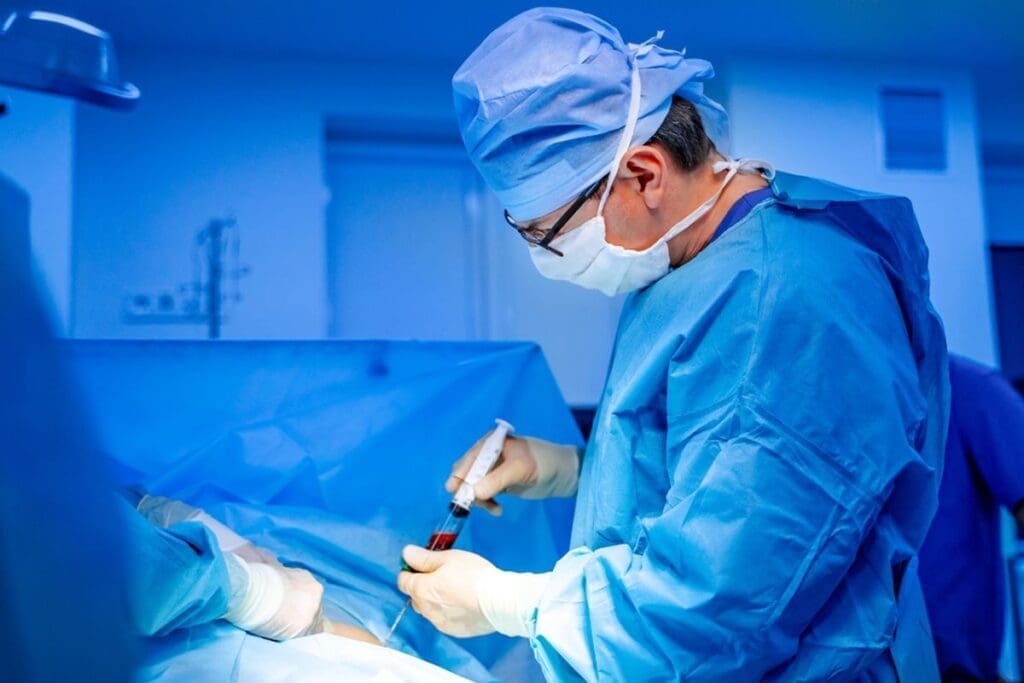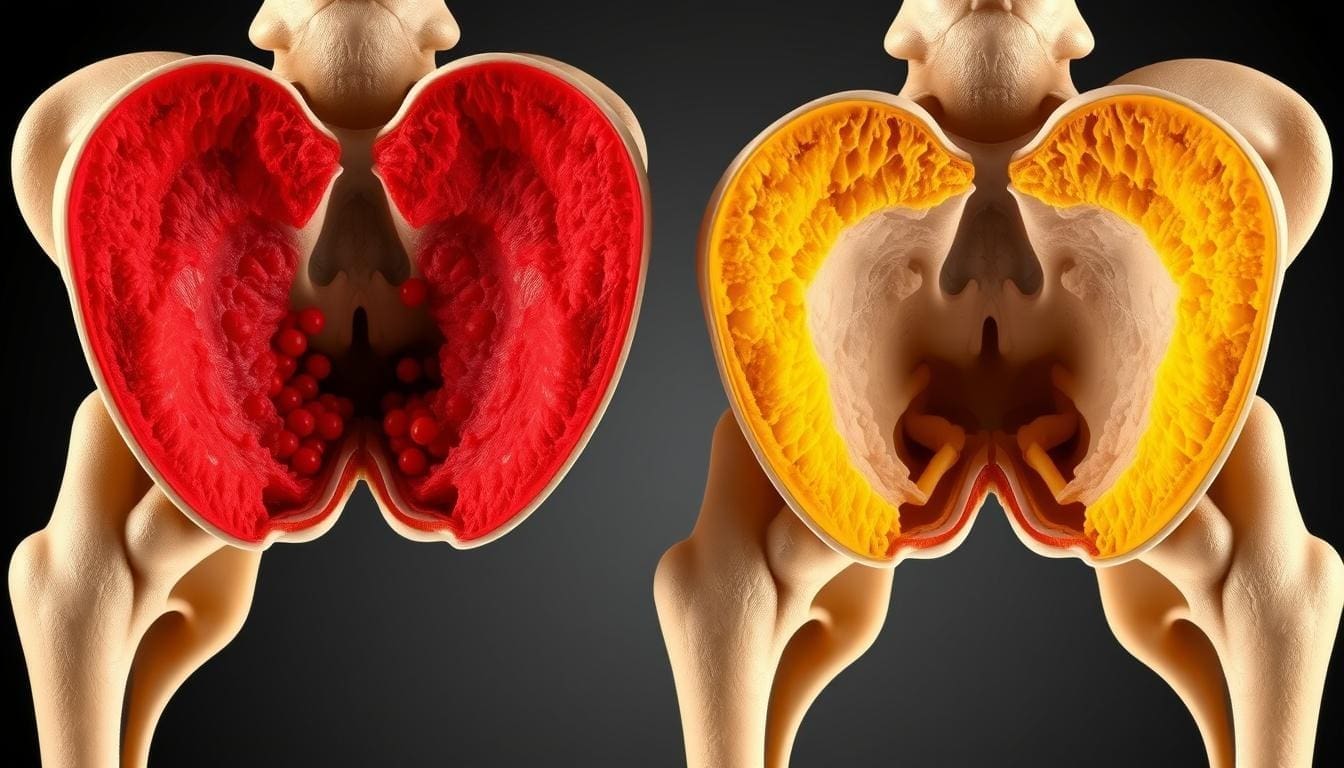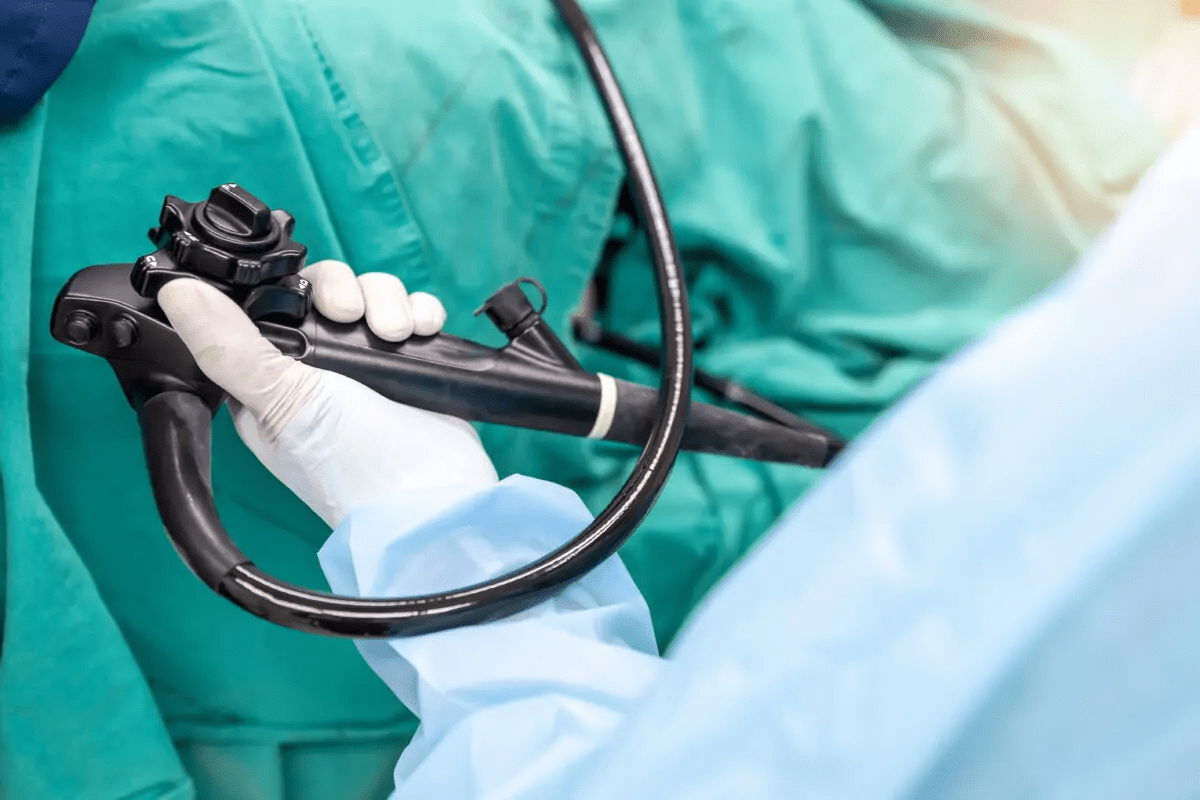Last Updated on November 26, 2025 by Bilal Hasdemir

A CT-guided bone marrow biopsy is a safe and precise way to take a sample of bone marrow. It uses CT imaging to find the right spot. This method is key for diagnosing blood-related diseases and other conditions.
At LivHospital, patients get the best care with the latest technology. This includes CT guided bone marrow biopsy, which helps doctors check the bone marrow inside some of the major bones.
Key Takeaways
- CT-guided bone marrow biopsy is a precise and safe procedure.
- Liv Hospital uses the latest medical technology for this procedure.
- The procedure is vital for diagnosing various hematologic disorders.
- Patient-centred care is a top priority at LivHospital.
- CT imaging allows for accurate localization and sampling.
Understanding Bone Marrow Biopsies

Bone marrow biopsies are key for checking bone marrow and blood cell health. They are used by doctors to see how well these parts are working.
What is Bone Marrow and Its Function
Bone marrow is soft tissue inside bones like hips and thighbones. It makes red blood cells, white blood cells, and platelets. A healthy bone marrow is vital for the body’s blood and immune systems.
Why Bone Marrow Sampling is Necessary
Bone marrow sampling helps find and track hematologic disorders like leukemia and lymphoma. It gives doctors the info they need to choose the right treatment.
What is a CT-Guided Bone Marrow Biopsy?
For patients needing a bone marrow biopsy, CT guidance is key. It’s great for deep or tricky spots. A strong X-ray makes detailed bone pictures, helping find the right spot for the biopsy.
Definition and Basic Procedure Overview
A CT-guided bone marrow biopsy mixes CT scans with biopsy methods. It gets bone marrow samples. A CT scanner shows real-time images, guiding the needle into the bone marrow.
This makes the biopsy more precise and safer. The steps start with a CT scan to find the best spot. Then, local anesthesia is given, and the needle is inserted under CT watch.
The Role of Computed Tomography in Guidance
Computed Tomography (CT) is vital for guiding bone marrow biopsies. It gives clear images of inside structures. This helps the team find and reach the right spot for the sample.
CT’s live images are a big plus for tricky locations. It makes the biopsy more accurate and safer.
Medical Indications for CT-Guided Bone Marrow Biopsies
CT-guided bone marrow biopsies are key in modern medicine. They help diagnose hematologic and oncologic disorders. These biopsies are precise, sampling bone marrow for diagnosis and management.
Diagnosing Hematologic Disorders
Hematologic disorders like leukemia, lymphoma, and multiple myeloma need bone marrow checks. CT-guided biopsies are reliable for getting marrow samples. This helps in diagnosing and staging these conditions accurately.
Detecting Metastatic Cancers
CT-guided biopsies are also vital for finding metastatic cancers in the bone marrow. Cancers from breast, prostate, and lung can spread to the bone marrow. A biopsy confirms the presence of these cancer cells. CT guidance targets the affected areas, improving diagnosis chances.
Other Clinical Indications
CT-guided bone marrow biopsies are used for more than just hematologic and metastatic cancers. They help diagnose aplastic anemia, assess bone marrow fibrosis, and investigate unexplained cytopenias. Their versatility and accuracy make them a valuable diagnostic tool.
| Clinical Indication | Description | Diagnostic Benefit |
| Hematologic Disorders | Diagnosis of leukemia, lymphoma, multiple myeloma | Accurate staging and diagnosis |
| Metastatic Cancers | Detection of cancer spread to bone marrow | Confirmation of metastasis |
| Aplastic Anemia | Assessment of bone marrow failure | Evaluation of marrow cellularity |
Advantages of CT-Guided Bone Marrow Biopsy
Using CT guidance in bone marrow biopsies boosts accuracy and cuts down on complications. This method is key in today’s medicine because of its many benefits.
Superior Accuracy and Precision
CT-guided bone marrow biopsies are superior in accuracy thanks to real-time CT imaging. This lets doctors precisely aim for the biopsy spot, lowering the chance of mistakes. It’s very important for diagnosing blood disorders and finding cancer spread.
Benefits for Anatomically Complex Sites
CT-guided bone marrow biopsies are great for anatomically complex sites. Places like the sternum and pelvis are hard to reach with old methods. But, CT guidance helps doctors get there easily, making sure the sample is right.
Reduced Complications and Increased Sampling Success
CT guidance in bone marrow biopsies cuts down on complications. It shows exactly where the needle is, avoiding damage to nearby tissues. This makes the procedure safer and more likely to succeed.
- Improved accuracy in targeting biopsy sites
- Enhanced ability to sample from complex anatomical locations
- Reduced risk of complications during the procedure
In summary, CT-guided bone marrow biopsies are a big help in today’s medical world.
Preparing for Your CT-Guided Bone Marrow Biopsy
Getting ready for your CT-guided bone marrow biopsy can make you feel less anxious. Knowing what to expect helps a lot. It’s important to prepare well for a good outcome.
Pre-Procedure Instructions
Your healthcare provider will give you specific instructions before the biopsy. They might tell you to stop certain medications or supplements that could affect the results. It’s very important to follow these instructions to avoid any problems.
Make a list of all the medications and supplements you’re taking. This will help you talk about them with your healthcare provider. Here are some examples:
- Blood thinners
- Aspirin
- Non-steroidal anti-inflammatory drugs (NSAIDs)
- Any herbal supplements
What to Bring and Wear
On the day of the procedure, wear comfortable, loose-fitting clothing that’s easy to move in. You might also need to wear a hospital gown. Don’t forget to bring your insurance cards, identification, and a list of your medications.
Discussing Concerns with Your Healthcare Provider
Talking to your healthcare provider about any worries or questions is key. This includes sharing any anxiety or fears you might have, as well as your medications. They can offer advice and reassurance to make you feel more at ease.
“Open communication with your healthcare provider is essential for a successful procedure. Don’t hesitate to ask questions or express your concerns.”
Here’s a table to help you discuss common concerns and questions with your healthcare provider:
| Concern/Question | Discussion Points |
| Medications | List of current medications, possible interactions |
| Procedure Risks | Possible complications, risk mitigation strategies |
| Post-Procedure Care | Instructions for recovery, follow-up appointments |
The CT-Guided Bone Marrow Biopsy Procedure Step by Step
Learning about the CT-guided bone marrow biopsy step by step can ease patient worries. It helps them know what to expect during the procedure.
Initial Positioning and CT Scanning
The first step is getting into position on a CT table. This position makes it easy to reach the biopsy site. Next, the CT scanner does a scan to find the exact spot for the biopsy.
Aseptic Technique and Local Anesthetic Administration
After finding the spot, the area is cleaned with an aseptic technique to prevent infection. A local anesthetic is given to numb the area. This makes sure the patient is comfortable during the procedure.
“The use of aseptic technique and local anesthetic is key to keeping patients safe and comfortable during the biopsy.”
The Biopsy Process
The biopsy itself involves putting a needle into the bone marrow under CT guidance. The CT scanner shows live images, helping the doctor aim exactly right. The bone marrow sample is then taken out and tested.
| Procedure Step | Description |
| Initial Positioning | Patient is placed on the CT table for the best access. |
| CT Scanning | A scan is done to find where to do the biopsy. |
| Aseptic Technique | The area is cleaned to lower the risk of infection. |
| Local Anesthetic | The area is numbed for comfort. |
| Biopsy | A needle is inserted into the bone marrow under CT guidance. |
Completion and Immediate Post-Procedure Steps
After the biopsy, the needle is taken out, and pressure is applied to stop bleeding. The patient is watched for a bit before being sent home.
The whole CT-guided bone marrow biopsy procedure usually takes 10 to 20 minutes. But, the whole visit might take longer because of getting ready and recovering.
What to Expect During a CT-Guided Bone Marrow Biopsy
Getting ready for a CT-guided bone marrow biopsy can feel scary. But knowing what to expect can make you feel better. It’s important to understand what happens during the biopsy.
Sensations and Discomfort Levels
You might feel a sharp pain or stinging when the needle goes into the bone. This pain is short-lived and can be eased with local anesthesia. Some people might feel pressure or discomfort, but it’s usually mild.
Here are the main sensations you might feel:
- A sharp pain or stinging during needle insertion
- Pressure or discomfort during the procedure
- Mild pain or soreness after the procedure
Duration: The 30-60 Minute Procedure
The whole procedure usually takes 30 to 60 minutes. It can take longer if your case is more complex or if more samples are needed. Your medical team will tell you how long it will take and what you need to do.
Communication with the Medical Team
Talking to your medical team is very important during the biopsy. Tell them about any worries, allergies, or health issues you have. You can talk or use hand signals if you need to. Don’t be shy about asking questions or sharing any discomfort.
Knowing what to expect can help you feel more ready for the biopsy. It can also help reduce any anxiety you might have.
Recovery and Aftercare Following the Procedure
After a CT-guided bone marrow biopsy, it’s key to follow aftercare closely. Resting and following care instructions helps avoid complications. It also ensures a quick recovery.
Immediate Post-Procedure Monitoring
Right after the procedure, patients are watched for any immediate issues. This happens in a recovery area. Medical staff keep an eye on vital signs and overall health.
At-Home Care Instructions
At-home care is vital for recovery. Patients get detailed instructions on caring for the biopsy site and managing pain. It’s important to follow wound care and medication instructions to avoid infection and aid healing.
| Care Instructions | Description |
| Wound Care | Keep the biopsy site clean and dry. Follow specific instructions provided by your healthcare provider. |
| Activity Level | Avoid strenuous activities for at least 24 hours post-procedure. |
| Medication | Adhere to prescribed medication regimens to manage pain and prevent infection. |
Activity Restrictions and Return to Normal Routine
Patients should avoid heavy lifting, bending, or strenuous activities for 24 hours after. The healthcare provider will guide on when to start normal activities. This depends on the patient’s recovery.
Potential Risks and Complications
CT-guided bone marrow biopsies are generally safe. But, it’s important to know the possible risks and complications. This knowledge helps patients make informed choices.
Common Side Effects
After a CT-guided bone marrow biopsy, you might feel pain or discomfort at the site. You could also see bruising and swelling. These effects are usually mild and go away in a few days. Proper aftercare can help reduce these symptoms.
Rare but Serious Complications
Though rare, serious issues can happen. These include too much bleeding, infection, or damage to nearby areas. CT guidance helps by making the biopsy more precise.
When to Seek Medical Attention
Knowing when to get help is key after a CT-guided bone marrow biopsy. Look out for signs like more pain, redness, swelling, fever, or unusual bleeding. If you notice any of these, reach out to your healthcare provider right away.
| Potential Complication | Symptoms to Watch For | Action to Take |
| Infection | Fever, redness, swelling, increasing pain | Contact healthcare provider |
| Excessive Bleeding | Uncontrolled bleeding, large bruise | Seek immediate medical attention |
| Nerve Damage | Numbness, tingling, persistent pain | Notify healthcare provider |
Understanding Your Biopsy Results
After a CT-guided bone marrow biopsy, knowing your results is key. The samples go to a lab for analysis. You’ll usually get the results in a few days.
Typical Timeline for Results: What to Expect
Results usually come in 3 to 5 working days. But, it can take longer if the test is complex. Your doctor will tell you when to expect your results.
Interpreting Common Findings
Understanding biopsy findings needs a good grasp of medical terms. Your doctor will explain the results in detail. They’ll talk about any diagnosis or abnormalities found.
“The diagnosis and management of hematologic disorders heavily rely on the accurate interpretation of bone marrow biopsy results.”
– Dr. Jane Smith, Hematologist
Follow-up Recommendations and Next Steps
Your healthcare team will suggest what to do next based on your biopsy results. This could be more tests, starting treatment, or just watching your condition. It’s important to ask any questions you have about your results and what’s next.
Conclusion: The Future of CT-Guided Bone Marrow Biopsies in Modern Medicine
CT-guided bone marrow biopsies are now key in modern medicine. They show the latest in how we diagnose diseases. Thanks to new imaging tech, these procedures are getting better and safer.
The future of CT-guided bone marrow biopsies is bright. New CT tech will make biopsies even more precise. This is vital for diagnosing and treating blood diseases and cancers.
As medicine keeps getting better, CT-guided biopsies will play an even bigger role. They will give doctors better tools to diagnose. This will help patients get better care and treatments.
Adding CT-guided bone marrow biopsies to medical practice is a big step. It shows how important new tech is in healthcare.
FAQ
What is a CT-guided bone marrow biopsy?
A CT-guided bone marrow biopsy is a procedure. It uses CT imaging to guide the collection of bone marrow samples. This is done for diagnostic purposes.
How long does a CT-guided bone marrow biopsy procedure take?
The procedure usually takes 30 to 60 minutes to complete.
How long does it take to receive the results of a bone marrow biopsy?
Results are usually available within a few days to a week after the procedure.
What are the advantages of using CT guidance during a bone marrow biopsy?
CT guidance makes the biopsy more accurate and precise. It also reduces the risk of complications. This increases the success rate, even in complex sites.
What should I expect during a CT-guided bone marrow biopsy?
You might feel some discomfort during the procedure. The pain level can vary. The medical team will keep you informed to ensure your comfort and safety.
How do I prepare for a CT-guided bone marrow biopsy?
Follow pre-procedure instructions, like fasting or stopping certain medications. Wear comfortable clothing. Discuss any concerns with your healthcare provider.
What are the possible risks and complications associated with CT-guided bone marrow biopsies?
Common side effects include pain, bruising, and bleeding at the biopsy site. Rare but serious complications can occur. It’s important to follow post-procedure instructions and seek medical attention if you experience unusual symptoms.
What is the role of computed tomography in a CT-guided bone marrow biopsy?
Computed tomography provides real-time imaging guidance. This allows the medical team to accurately target the biopsy site and collect samples with precision.
Can I resume normal activities after a CT-guided bone marrow biopsy?
You will be monitored after the procedure. Your healthcare provider will guide you on activity restrictions and when you can return to your normal routine.
How is a CT-guided bone marrow biopsy different from other types of biopsies?
CT guidance offers superior accuracy and precision. This makes it useful for complex or hard-to-reach biopsy sites.
What are the medical indications for a CT-guided bone marrow biopsy?
CT-guided bone marrow biopsies are used to diagnose hematologic disorders. They are also used to detect metastatic cancers and monitor treatment response.
Reference:
- Roman, A. (2018). CT-guided procedures: An initial experience. PMC, 2018 Oct 29. Retrieved from https://pmc.ncbi.nlm.nih.gov/articles/PMC6296730/






